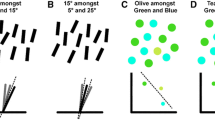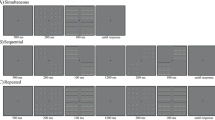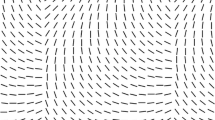Abstract
Corners, or discontinuities in orientation, are one of the most salient and useful properties of contours. But how sensitive are we in detecting them, and what does this sensitivity imply about the processes by which corners can be detected. In this paper we address both of these questions, starting with the observation that changing the samplign phase of a curve changes the geometry of its discrete trace, or the set of discrete (retinotopic) points onto which the curve projects. This motivates our stimuli — dotted curves —and our experimental design: if curves are represented by dots, the placement of the dots effects whether or not corners are perceived. Specifically, we present quantitative data on sensitivity to discontinuities as a function of dot phase, and address its theoretical explanation within a two-stage model of orientation selection. Curvature plays a key role in this model, and, finally, the model and experimental data are brought together by showing that a very coarse approximation to change in curvature (or differences in local curvature estimates) is sufficent to account for the psychophysical data on sensitivity to discontinuities.
Similar content being viewed by others
References
Attneave F (1957) Physical determinants of the judged complexity of shapes. J Exp Psychol 53:221–227
Attneave F, Arnoult MD (1956) The quantitative study of shape and pattern perception. Psychol Bull 53:452–471
do Carmo M (1976) Differential geometry of curves and surfaces. Prentice-Hall, Englewood Cliffs
Crassini B, Over R (1975) Masking, after-effect and illusion in the visual perception of curvature. Percept Psychophys 17:411–416
Dobbins A, Zucker SW, Cynader M (1987) Endstopped neurons in the visual cortex as a substrate for calculating curvature. Nature 329:438–441
Feng FY, Pavlidis T (1973) Finding “vertices” in a picture. Comput Graph Im Proc 2:103–117
Foster DH (1983) Visual discrimination, categorical identification, and categorical rating in brief displays of curved lines: implications for discrete encoding processes. J Exp Psychol 9:785–806
Freeman H, Davis LS (1977) A corner-finding algorithm for chain-coded curves. IEEE Trans Comput 26:297–303
Freund JE (1971) Mathematical statistics, 2nd edn. Prentice-Hall, Englewood Cliffs
Geman S, Geman D (1984) Stochastic relaxation, Gibbs distribution, and the Bayesian restoration of images. IEEE Trans PAMI-6:721–741
Heggelund P, Hohmann A (1975) Responses of striate cortical cells to moving edges of different curvature. Exp Brain Res 23:211–216
Hubel D, Wiesel T (1962) Receptive fields, binocular interaction and functional architecture in the cat's visual cortex. J Physiol (London) 160:106–154
Hubel D, Wiesel T (1977) Functional architecture of macaque monkey visual cortex. Proc R Soc (London) B 198:1–59
Iverson L, Zucker SW (1987) Orientation selection to optical flow: a computational perspective. Proc IEEE Workshop on Computer Vision, Miami
Koenderink J, van Doorn A (1987) Representation of local geometry in the visual system. Biol Cybern 55:367–375
Kruse B, Rao CVK (1978) A matched filtering technique for corner detection. Proceedings of the 4th International Joint Conference on Pattern Recognition, Kyoto, Japan, November 7–10, 1978, pp 642–644
Link NK, Zucker SW (1987) Sensitivity to corners in flow patterns. Spat Vis 2:233–244
Movshor A, Blakemore C (1973) Orientation specificity and spatial selectivity in human vision. Perception 2:53–60
Orban G (1984) Neuronal operations in the visual cortex. Springer, Berlin Heidelberg New York
Parent P, Zucker SW (1985) Curvature consistency and curve detection. Technical Report 85-12R. Montréal: Dept of Elect Eng, McGill University; IEEE Trans PAMI (in press)
Riggs LA (1973) Curvature as a feature of pattern vision. Science 181:1070–1072
Rosenfeld A, Johnston E (1973) Angle detection on digital curves. IEEE Trans Comput 22:875–878
Schiller PH, Finlay BL, Volman SF (1976) Quantitative studies of single-cell properties in monkey striate cortex. II. Orientation specificity and ocular dominance. J Neurophysiol 39:1320–1333
Timney BN, Macdonald C (1978) Are curves detected by “curvature detectors”? Perception 7:51–64
Watt RJ, Andrews DP (1982) Contour curvature analysis: hyperacuities in the discrimination of detailed shape. Vision Res 22:449–460
Zucker SW (1982) Early orientation selection and grouping: type I and type II processes. Technical Report 82-6R. Montréal: Dept of Elect Eng, McGill University
Zucker SW (1984) Type I and Type II processes in early orientation selection. In: Caelli T, Dodwell P (eds) Figural synthesis. Erlbaum, Hillsdale, NJ
Zucker SW (1985) Early orientation selection: tangent fields and the dimensionality of their support. Comput Vision Graph Image Process 32:74–103
Zucker SW (1986) The computational connection in vision: early orientation election. Beh Res Methods Instrum Comp 18:608–617
Zucker SW, Davis S (1985) Points and endpoints: a size/spacing constraint for dot grouping. Technical Report 85-3R. Montréal: Dept of Elect Eng, McGill University. Perception (in press)
Author information
Authors and Affiliations
Rights and permissions
About this article
Cite this article
Link, N.K., Zucker, S.W. Corner detection in curvilinear dot grouping. Biol. Cybern. 59, 247–256 (1988). https://doi.org/10.1007/BF00332913
Received:
Published:
Issue Date:
DOI: https://doi.org/10.1007/BF00332913




